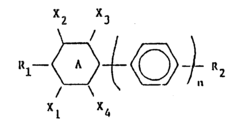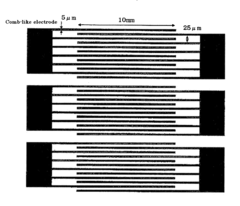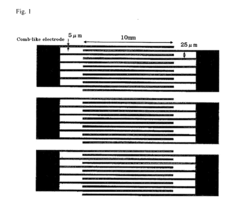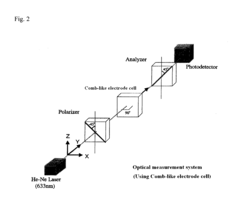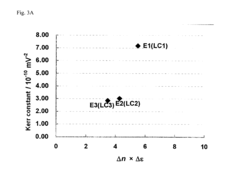Characterization of Geometric Isomers in Liquid Crystalline Materials
AUG 1, 202510 MIN READ
Generate Your Research Report Instantly with AI Agent
Patsnap Eureka helps you evaluate technical feasibility & market potential.
LC Isomer Background
Liquid crystalline materials have been a subject of intense research and development for several decades due to their unique properties that bridge the gap between conventional liquids and solid crystals. These materials exhibit both fluidity and long-range molecular order, making them invaluable in various applications, particularly in display technologies. The study of geometric isomers in liquid crystalline materials is a crucial aspect of this field, as the spatial arrangement of molecules significantly influences the material's properties and performance.
Geometric isomers, also known as configurational isomers, are compounds with the same molecular formula but different spatial arrangements of atoms. In the context of liquid crystals, these isomers can dramatically affect the material's phase transitions, optical properties, and overall behavior. The most common types of geometric isomers encountered in liquid crystalline materials are cis-trans isomers, where the relative position of substituents around a double bond or ring structure can vary.
The history of research into geometric isomers in liquid crystals dates back to the early 20th century, with significant advancements made in the 1960s and 1970s. During this period, scientists began to recognize the importance of molecular structure in determining liquid crystalline properties. The discovery of various mesophases, such as nematic, smectic, and cholesteric, further highlighted the need for a deeper understanding of molecular geometry and its effects on material behavior.
Characterization of geometric isomers in liquid crystalline materials involves a multidisciplinary approach, combining techniques from organic chemistry, physical chemistry, and materials science. Key methods include spectroscopic techniques such as nuclear magnetic resonance (NMR) and infrared (IR) spectroscopy, which can provide detailed information about molecular structure and conformation. X-ray diffraction and polarized optical microscopy are also essential tools for studying the arrangement of molecules in different liquid crystalline phases.
The presence of geometric isomers can lead to significant variations in the physical properties of liquid crystalline materials. For instance, the cis-trans isomerism in azobenzene-based liquid crystals has been extensively studied due to its photoswitchable nature, allowing for light-controlled changes in material properties. This phenomenon has potential applications in optical data storage, smart windows, and responsive materials.
Understanding and controlling the distribution of geometric isomers in liquid crystalline materials is crucial for optimizing their performance in various applications. In display technologies, the precise control of molecular orientation and switching behavior is essential for achieving high contrast ratios and fast response times. The presence of unwanted isomers can lead to defects, reduced efficiency, and compromised device performance.
As research in this field progresses, new challenges and opportunities continue to emerge. The development of advanced characterization techniques, such as two-dimensional NMR spectroscopy and synchrotron-based X-ray methods, is enabling more detailed analysis of complex liquid crystalline systems. Additionally, computational modeling and simulation tools are becoming increasingly important in predicting the behavior of geometric isomers and guiding the design of novel liquid crystalline materials with tailored properties.
Geometric isomers, also known as configurational isomers, are compounds with the same molecular formula but different spatial arrangements of atoms. In the context of liquid crystals, these isomers can dramatically affect the material's phase transitions, optical properties, and overall behavior. The most common types of geometric isomers encountered in liquid crystalline materials are cis-trans isomers, where the relative position of substituents around a double bond or ring structure can vary.
The history of research into geometric isomers in liquid crystals dates back to the early 20th century, with significant advancements made in the 1960s and 1970s. During this period, scientists began to recognize the importance of molecular structure in determining liquid crystalline properties. The discovery of various mesophases, such as nematic, smectic, and cholesteric, further highlighted the need for a deeper understanding of molecular geometry and its effects on material behavior.
Characterization of geometric isomers in liquid crystalline materials involves a multidisciplinary approach, combining techniques from organic chemistry, physical chemistry, and materials science. Key methods include spectroscopic techniques such as nuclear magnetic resonance (NMR) and infrared (IR) spectroscopy, which can provide detailed information about molecular structure and conformation. X-ray diffraction and polarized optical microscopy are also essential tools for studying the arrangement of molecules in different liquid crystalline phases.
The presence of geometric isomers can lead to significant variations in the physical properties of liquid crystalline materials. For instance, the cis-trans isomerism in azobenzene-based liquid crystals has been extensively studied due to its photoswitchable nature, allowing for light-controlled changes in material properties. This phenomenon has potential applications in optical data storage, smart windows, and responsive materials.
Understanding and controlling the distribution of geometric isomers in liquid crystalline materials is crucial for optimizing their performance in various applications. In display technologies, the precise control of molecular orientation and switching behavior is essential for achieving high contrast ratios and fast response times. The presence of unwanted isomers can lead to defects, reduced efficiency, and compromised device performance.
As research in this field progresses, new challenges and opportunities continue to emerge. The development of advanced characterization techniques, such as two-dimensional NMR spectroscopy and synchrotron-based X-ray methods, is enabling more detailed analysis of complex liquid crystalline systems. Additionally, computational modeling and simulation tools are becoming increasingly important in predicting the behavior of geometric isomers and guiding the design of novel liquid crystalline materials with tailored properties.
Market Analysis
The market for liquid crystalline materials has been experiencing steady growth, driven by their unique properties and diverse applications across various industries. The characterization of geometric isomers in these materials plays a crucial role in determining their performance and suitability for specific applications, making it a key focus area for market players and researchers alike.
In the display technology sector, liquid crystal displays (LCDs) continue to dominate the market, particularly in consumer electronics such as smartphones, tablets, and televisions. The demand for high-quality, energy-efficient displays has led to increased research and development efforts in optimizing liquid crystalline materials, with a particular emphasis on understanding and controlling geometric isomers to enhance display performance.
The automotive industry has also emerged as a significant market for liquid crystalline materials, with applications in smart windows, heads-up displays, and instrument panels. The ability to characterize and manipulate geometric isomers in these materials allows for improved optical properties and durability, meeting the stringent requirements of automotive applications.
In the field of photonics and optical communications, liquid crystalline materials are gaining traction due to their tunable optical properties. The characterization of geometric isomers in these materials is essential for developing advanced optical devices, such as tunable filters, optical switches, and waveguides. This market segment is expected to grow as the demand for high-speed data transmission and processing continues to increase.
The healthcare and biomedical sectors represent another promising market for liquid crystalline materials. Applications include biosensors, drug delivery systems, and tissue engineering scaffolds. The ability to precisely characterize geometric isomers in these materials is crucial for ensuring biocompatibility and optimizing their performance in medical applications.
The growing focus on sustainable and eco-friendly technologies has also created opportunities for liquid crystalline materials in the renewable energy sector. Applications such as smart windows for energy-efficient buildings and organic photovoltaics benefit from the unique properties of these materials, with geometric isomer characterization playing a vital role in optimizing their performance.
As the market for liquid crystalline materials continues to expand, the demand for advanced characterization techniques and tools is also increasing. This has led to the development of specialized analytical instruments and software solutions designed specifically for studying geometric isomers in these materials, creating a secondary market within the broader liquid crystal industry.
Overall, the market for characterization of geometric isomers in liquid crystalline materials is closely tied to the growth of various end-use industries. As these industries continue to evolve and demand more sophisticated materials, the importance of accurate and efficient characterization techniques will only grow, driving further innovation and market expansion in this field.
In the display technology sector, liquid crystal displays (LCDs) continue to dominate the market, particularly in consumer electronics such as smartphones, tablets, and televisions. The demand for high-quality, energy-efficient displays has led to increased research and development efforts in optimizing liquid crystalline materials, with a particular emphasis on understanding and controlling geometric isomers to enhance display performance.
The automotive industry has also emerged as a significant market for liquid crystalline materials, with applications in smart windows, heads-up displays, and instrument panels. The ability to characterize and manipulate geometric isomers in these materials allows for improved optical properties and durability, meeting the stringent requirements of automotive applications.
In the field of photonics and optical communications, liquid crystalline materials are gaining traction due to their tunable optical properties. The characterization of geometric isomers in these materials is essential for developing advanced optical devices, such as tunable filters, optical switches, and waveguides. This market segment is expected to grow as the demand for high-speed data transmission and processing continues to increase.
The healthcare and biomedical sectors represent another promising market for liquid crystalline materials. Applications include biosensors, drug delivery systems, and tissue engineering scaffolds. The ability to precisely characterize geometric isomers in these materials is crucial for ensuring biocompatibility and optimizing their performance in medical applications.
The growing focus on sustainable and eco-friendly technologies has also created opportunities for liquid crystalline materials in the renewable energy sector. Applications such as smart windows for energy-efficient buildings and organic photovoltaics benefit from the unique properties of these materials, with geometric isomer characterization playing a vital role in optimizing their performance.
As the market for liquid crystalline materials continues to expand, the demand for advanced characterization techniques and tools is also increasing. This has led to the development of specialized analytical instruments and software solutions designed specifically for studying geometric isomers in these materials, creating a secondary market within the broader liquid crystal industry.
Overall, the market for characterization of geometric isomers in liquid crystalline materials is closely tied to the growth of various end-use industries. As these industries continue to evolve and demand more sophisticated materials, the importance of accurate and efficient characterization techniques will only grow, driving further innovation and market expansion in this field.
Current Challenges
The characterization of geometric isomers in liquid crystalline materials presents several significant challenges that researchers and industry professionals are currently grappling with. One of the primary difficulties lies in the precise identification and quantification of different isomeric forms within complex liquid crystal mixtures. Traditional analytical techniques often struggle to differentiate between subtle structural variations, particularly when dealing with molecules that exhibit similar physical properties.
Spectroscopic methods, such as Nuclear Magnetic Resonance (NMR) and Infrared (IR) spectroscopy, while powerful, can sometimes yield ambiguous results when analyzing closely related isomers. This ambiguity is exacerbated by the dynamic nature of liquid crystalline phases, where molecular orientations and interactions can influence spectral signatures. Consequently, developing more sensitive and selective spectroscopic techniques remains an ongoing challenge in the field.
Another significant hurdle is the real-time monitoring of isomeric composition during phase transitions or under varying environmental conditions. Liquid crystalline materials often undergo complex phase behaviors, and the distribution of geometric isomers can shift dynamically. Current analytical methods typically provide snapshot analyses rather than continuous, in-situ measurements, limiting our understanding of isomeric transformations and their impact on material properties.
The miniaturization of characterization techniques poses yet another challenge. As liquid crystal technologies advance towards smaller devices and displays, there is an increasing need for analytical methods capable of probing isomeric compositions at the microscale or even nanoscale level. Developing such high-resolution techniques while maintaining accuracy and reliability is a formidable task that researchers are actively pursuing.
Furthermore, the influence of geometric isomerism on the macroscopic properties of liquid crystalline materials is not always straightforward to predict or measure. While it is known that isomeric composition can significantly affect properties such as phase transition temperatures, viscosity, and optical characteristics, establishing quantitative structure-property relationships remains challenging. This difficulty is compounded by the fact that many liquid crystal formulations are complex mixtures, where the interplay between different isomers and other components can lead to emergent behaviors that are not easily deduced from individual molecular properties.
Lastly, the development of standardized protocols for isomer characterization across different liquid crystalline systems is an ongoing challenge. The diversity of liquid crystal structures and applications means that a one-size-fits-all approach is often inadequate. Establishing robust, universally applicable methodologies for isomer analysis would greatly facilitate comparisons between different studies and accelerate progress in the field.
Spectroscopic methods, such as Nuclear Magnetic Resonance (NMR) and Infrared (IR) spectroscopy, while powerful, can sometimes yield ambiguous results when analyzing closely related isomers. This ambiguity is exacerbated by the dynamic nature of liquid crystalline phases, where molecular orientations and interactions can influence spectral signatures. Consequently, developing more sensitive and selective spectroscopic techniques remains an ongoing challenge in the field.
Another significant hurdle is the real-time monitoring of isomeric composition during phase transitions or under varying environmental conditions. Liquid crystalline materials often undergo complex phase behaviors, and the distribution of geometric isomers can shift dynamically. Current analytical methods typically provide snapshot analyses rather than continuous, in-situ measurements, limiting our understanding of isomeric transformations and their impact on material properties.
The miniaturization of characterization techniques poses yet another challenge. As liquid crystal technologies advance towards smaller devices and displays, there is an increasing need for analytical methods capable of probing isomeric compositions at the microscale or even nanoscale level. Developing such high-resolution techniques while maintaining accuracy and reliability is a formidable task that researchers are actively pursuing.
Furthermore, the influence of geometric isomerism on the macroscopic properties of liquid crystalline materials is not always straightforward to predict or measure. While it is known that isomeric composition can significantly affect properties such as phase transition temperatures, viscosity, and optical characteristics, establishing quantitative structure-property relationships remains challenging. This difficulty is compounded by the fact that many liquid crystal formulations are complex mixtures, where the interplay between different isomers and other components can lead to emergent behaviors that are not easily deduced from individual molecular properties.
Lastly, the development of standardized protocols for isomer characterization across different liquid crystalline systems is an ongoing challenge. The diversity of liquid crystal structures and applications means that a one-size-fits-all approach is often inadequate. Establishing robust, universally applicable methodologies for isomer analysis would greatly facilitate comparisons between different studies and accelerate progress in the field.
Characterization Methods
01 Synthesis of liquid crystalline materials with geometric isomers
Methods for synthesizing liquid crystalline materials that exhibit geometric isomerism. These processes often involve the creation of compounds with specific molecular structures that can exist in different spatial arrangements, leading to unique liquid crystalline properties.- Synthesis of liquid crystalline materials with geometric isomers: Methods for synthesizing liquid crystalline materials that exhibit geometric isomerism. These processes involve creating compounds with specific molecular structures that can exist in different spatial arrangements, affecting their liquid crystalline properties.
- Applications of geometric isomers in liquid crystal displays: Utilization of geometric isomers in liquid crystal display technologies. These materials can be used to enhance display performance, including improved contrast, viewing angles, and response times.
- Characterization and analysis of liquid crystalline geometric isomers: Techniques for identifying and analyzing geometric isomers in liquid crystalline materials. This includes spectroscopic methods, thermal analysis, and other analytical approaches to determine the structure and properties of these compounds.
- Formulation of liquid crystal mixtures containing geometric isomers: Development of liquid crystal mixtures that incorporate geometric isomers to achieve specific properties. These formulations can be tailored for various applications, such as displays, sensors, or optical devices.
- Stabilization and control of geometric isomers in liquid crystalline materials: Methods for stabilizing and controlling the ratio of geometric isomers in liquid crystalline materials. This includes techniques to maintain desired isomer ratios and prevent unwanted isomerization, ensuring consistent performance in applications.
02 Applications of geometric isomers in liquid crystal displays
Utilization of geometric isomers in liquid crystal display technologies. These materials can be used to enhance display performance, improve viewing angles, or create novel display effects based on the unique properties of different isomeric forms.Expand Specific Solutions03 Characterization and analysis of liquid crystalline geometric isomers
Techniques for identifying, analyzing, and characterizing geometric isomers in liquid crystalline materials. This may include spectroscopic methods, thermal analysis, or other analytical techniques to distinguish between different isomeric forms and understand their properties.Expand Specific Solutions04 Formulation of liquid crystal mixtures containing geometric isomers
Development of liquid crystal mixtures that incorporate geometric isomers to achieve specific properties or performance characteristics. This may involve combining different isomeric forms or using additives to stabilize certain geometries.Expand Specific Solutions05 Control and manipulation of geometric isomers in liquid crystalline systems
Methods for controlling or manipulating the geometric isomerism of liquid crystalline materials. This could include techniques for switching between isomeric forms, stabilizing specific geometries, or using external stimuli to induce isomerization in liquid crystal systems.Expand Specific Solutions
Key Industry Players
The characterization of geometric isomers in liquid crystalline materials is a niche yet crucial field in the advanced materials industry. The market is in a growth phase, driven by increasing demand for high-performance displays and optical devices. The global liquid crystal materials market is projected to reach several billion dollars by 2025, with a compound annual growth rate of around 5-7%. Technologically, the field is moderately mature, with established players like JNC Corp., DIC Corp., and JSR Corp. leading in research and development. However, there's still room for innovation, particularly in improving isomer characterization techniques and developing novel liquid crystal formulations. Emerging companies like Jiangsu Hecheng Display Technology and Shijiazhuang Chengzhi Yonghua Display Materials are also contributing to the competitive landscape, focusing on specialized applications and regional markets.
JNC Corp.
Technical Solution: JNC Corp. has developed advanced characterization techniques for geometric isomers in liquid crystalline materials. Their approach combines high-resolution nuclear magnetic resonance (NMR) spectroscopy with sophisticated computational modeling to accurately identify and quantify different isomeric structures[1]. This method allows for precise determination of cis-trans ratios and conformational distributions in complex liquid crystal mixtures. JNC Corp. has also implemented polarized Raman spectroscopy to study the orientation and order parameters of geometric isomers in various mesophases[3]. Their holistic characterization strategy integrates multiple analytical techniques to provide comprehensive insights into the molecular structure and behavior of liquid crystalline materials.
Strengths: Comprehensive analytical approach, high accuracy in isomer identification. Weaknesses: Potentially time-consuming and resource-intensive characterization process.
DIC Corp.
Technical Solution: DIC Corp. has pioneered a novel approach to characterizing geometric isomers in liquid crystalline materials using synchrotron-based X-ray diffraction techniques. Their method employs grazing-incidence wide-angle X-ray scattering (GIWAXS) to probe the molecular packing and orientation of isomers within thin films[2]. This non-destructive technique allows for in-situ analysis of phase transitions and isomer interconversions. DIC Corp. has also developed a proprietary algorithm for deconvoluting complex diffraction patterns, enabling quantitative analysis of isomer ratios in multi-component systems[4]. Additionally, they have integrated polarized optical microscopy with their X-ray techniques to correlate macroscopic textures with molecular-level isomeric structures.
Strengths: Non-destructive analysis, capability for in-situ measurements. Weaknesses: Requires access to specialized synchrotron facilities, which may limit widespread application.
Innovative Techniques
Liquid crystalline materials and method of making same
PatentInactiveEP0372094A1
Innovation
- Development of a family of chemically stable liquid crystalline compounds with low viscosities, characterized by specific substitution patterns and structures, allowing for mixability with other compounds to achieve lower viscosity mixtures, and the use of alkyl and alkoxy derivatives to enhance stability and optical properties.
Liquid crystal composition and liquid crystal element
PatentInactiveUS20090059132A1
Innovation
- A liquid crystal composition comprising compounds with alkenyl or difluoroalkenyl groups and chiral dopants, where the content of compounds with 3 or more ring structures is 15 wt% or more, and specific structural modifications to enhance the Kerr constant and reduce drive voltage.
Regulatory Compliance
The regulatory landscape for liquid crystalline materials, particularly in the context of geometric isomer characterization, is complex and multifaceted. Compliance with various regulatory frameworks is crucial for manufacturers, researchers, and end-users of these materials. The European Union's REACH (Registration, Evaluation, Authorization, and Restriction of Chemicals) regulation is a key consideration, requiring detailed information on the chemical composition and properties of liquid crystalline materials, including their geometric isomers.
In the United States, the Food and Drug Administration (FDA) plays a significant role in regulating liquid crystalline materials used in pharmaceuticals and medical devices. The FDA's guidelines on impurity profiling and characterization are particularly relevant to the identification and quantification of geometric isomers in these materials. Additionally, the Environmental Protection Agency (EPA) oversees the environmental impact and safety of chemical substances, including liquid crystals, under the Toxic Substances Control Act (TSCA).
Japan's regulatory framework, administered by the Ministry of Health, Labour and Welfare, also imposes strict requirements on the characterization and reporting of chemical substances, including liquid crystalline materials. The Japan Chemical Substances Control Law (CSCL) mandates detailed reporting on the composition and properties of new chemical substances, which would encompass geometric isomers in liquid crystals.
International standards, such as those set by the International Organization for Standardization (ISO), provide guidelines for the characterization and quality control of liquid crystalline materials. ISO 17025, which specifies the general requirements for the competence of testing and calibration laboratories, is particularly relevant for facilities conducting geometric isomer characterization.
The pharmaceutical industry faces additional regulatory scrutiny when using liquid crystalline materials. The International Conference on Harmonisation (ICH) guidelines, particularly ICH Q3A and Q3B on impurities in new drug substances and products, are critical for ensuring the proper characterization and control of geometric isomers in pharmaceutical applications of liquid crystals.
Regulatory compliance also extends to labeling and safety data sheets (SDS) for liquid crystalline materials. The Globally Harmonized System of Classification and Labelling of Chemicals (GHS) requires accurate identification and characterization of all components, including geometric isomers, to ensure proper hazard communication.
As the field of liquid crystalline materials continues to evolve, regulatory bodies are likely to update their requirements for characterization and reporting. Manufacturers and researchers must stay abreast of these changes to ensure ongoing compliance and to facilitate the safe and effective use of these materials across various industries.
In the United States, the Food and Drug Administration (FDA) plays a significant role in regulating liquid crystalline materials used in pharmaceuticals and medical devices. The FDA's guidelines on impurity profiling and characterization are particularly relevant to the identification and quantification of geometric isomers in these materials. Additionally, the Environmental Protection Agency (EPA) oversees the environmental impact and safety of chemical substances, including liquid crystals, under the Toxic Substances Control Act (TSCA).
Japan's regulatory framework, administered by the Ministry of Health, Labour and Welfare, also imposes strict requirements on the characterization and reporting of chemical substances, including liquid crystalline materials. The Japan Chemical Substances Control Law (CSCL) mandates detailed reporting on the composition and properties of new chemical substances, which would encompass geometric isomers in liquid crystals.
International standards, such as those set by the International Organization for Standardization (ISO), provide guidelines for the characterization and quality control of liquid crystalline materials. ISO 17025, which specifies the general requirements for the competence of testing and calibration laboratories, is particularly relevant for facilities conducting geometric isomer characterization.
The pharmaceutical industry faces additional regulatory scrutiny when using liquid crystalline materials. The International Conference on Harmonisation (ICH) guidelines, particularly ICH Q3A and Q3B on impurities in new drug substances and products, are critical for ensuring the proper characterization and control of geometric isomers in pharmaceutical applications of liquid crystals.
Regulatory compliance also extends to labeling and safety data sheets (SDS) for liquid crystalline materials. The Globally Harmonized System of Classification and Labelling of Chemicals (GHS) requires accurate identification and characterization of all components, including geometric isomers, to ensure proper hazard communication.
As the field of liquid crystalline materials continues to evolve, regulatory bodies are likely to update their requirements for characterization and reporting. Manufacturers and researchers must stay abreast of these changes to ensure ongoing compliance and to facilitate the safe and effective use of these materials across various industries.
Environmental Impact
The environmental impact of liquid crystalline materials containing geometric isomers is a critical consideration in their development, production, and application. These materials, widely used in display technologies and other advanced applications, can have significant implications for ecosystems and human health throughout their lifecycle.
During the manufacturing process of liquid crystalline materials, the synthesis and purification of geometric isomers often involve the use of organic solvents and potentially hazardous chemicals. These processes can lead to air and water pollution if not properly managed. Additionally, the energy-intensive nature of isomer separation techniques contributes to increased carbon emissions, further impacting climate change.
The disposal of liquid crystal displays (LCDs) containing geometric isomers presents another environmental challenge. As consumer electronics become obsolete at an increasing rate, the improper disposal of LCD screens can result in the leaching of harmful substances into soil and groundwater. The presence of geometric isomers in these materials may complicate recycling efforts, as different isomeric forms may require specialized separation techniques for effective recovery and reuse.
However, the unique properties of geometric isomers in liquid crystalline materials also offer potential environmental benefits. Their ability to change optical properties with minimal energy input can lead to more energy-efficient display technologies, reducing overall power consumption and associated carbon emissions. Furthermore, the development of bio-based liquid crystals utilizing naturally occurring geometric isomers could provide a more sustainable alternative to petroleum-derived materials.
Research into the biodegradability of liquid crystalline materials containing geometric isomers is ongoing. Some studies suggest that certain isomeric forms may be more susceptible to natural breakdown processes, potentially reducing their long-term environmental persistence. However, the complex molecular structures of these materials often result in slow degradation rates, raising concerns about their accumulation in ecosystems.
The potential for bioaccumulation of geometric isomers from liquid crystalline materials in aquatic and terrestrial organisms is an area of growing concern. While the toxicity of many of these compounds is relatively low, their persistence and potential for biomagnification through food chains warrant careful monitoring and further investigation.
As regulations surrounding electronic waste and chemical safety become more stringent, manufacturers are increasingly focused on developing liquid crystalline materials with reduced environmental impact. This includes exploring green chemistry approaches to isomer synthesis, improving the efficiency of separation processes, and designing products for easier disassembly and recycling at end-of-life.
During the manufacturing process of liquid crystalline materials, the synthesis and purification of geometric isomers often involve the use of organic solvents and potentially hazardous chemicals. These processes can lead to air and water pollution if not properly managed. Additionally, the energy-intensive nature of isomer separation techniques contributes to increased carbon emissions, further impacting climate change.
The disposal of liquid crystal displays (LCDs) containing geometric isomers presents another environmental challenge. As consumer electronics become obsolete at an increasing rate, the improper disposal of LCD screens can result in the leaching of harmful substances into soil and groundwater. The presence of geometric isomers in these materials may complicate recycling efforts, as different isomeric forms may require specialized separation techniques for effective recovery and reuse.
However, the unique properties of geometric isomers in liquid crystalline materials also offer potential environmental benefits. Their ability to change optical properties with minimal energy input can lead to more energy-efficient display technologies, reducing overall power consumption and associated carbon emissions. Furthermore, the development of bio-based liquid crystals utilizing naturally occurring geometric isomers could provide a more sustainable alternative to petroleum-derived materials.
Research into the biodegradability of liquid crystalline materials containing geometric isomers is ongoing. Some studies suggest that certain isomeric forms may be more susceptible to natural breakdown processes, potentially reducing their long-term environmental persistence. However, the complex molecular structures of these materials often result in slow degradation rates, raising concerns about their accumulation in ecosystems.
The potential for bioaccumulation of geometric isomers from liquid crystalline materials in aquatic and terrestrial organisms is an area of growing concern. While the toxicity of many of these compounds is relatively low, their persistence and potential for biomagnification through food chains warrant careful monitoring and further investigation.
As regulations surrounding electronic waste and chemical safety become more stringent, manufacturers are increasingly focused on developing liquid crystalline materials with reduced environmental impact. This includes exploring green chemistry approaches to isomer synthesis, improving the efficiency of separation processes, and designing products for easier disassembly and recycling at end-of-life.
Unlock deeper insights with Patsnap Eureka Quick Research — get a full tech report to explore trends and direct your research. Try now!
Generate Your Research Report Instantly with AI Agent
Supercharge your innovation with Patsnap Eureka AI Agent Platform!
